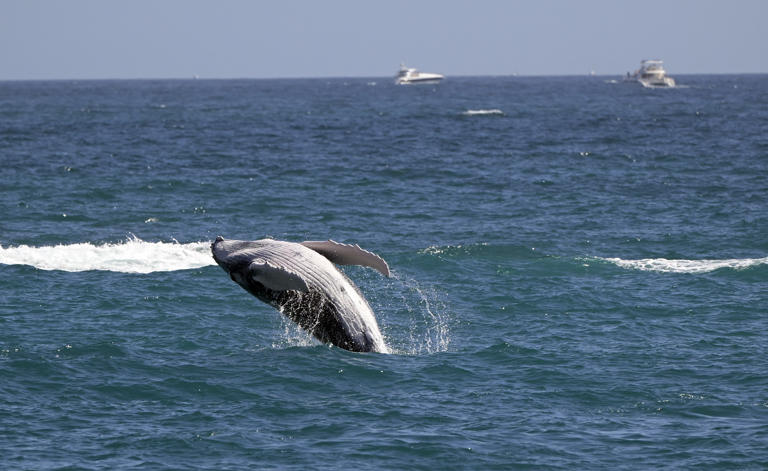Hello Guys, welcome again to Gistrepiublic. It’s nice to have you here.
There have been some recent news or rather reports that a whale that has been missing for a long time was sighted.
This has been a surprise for everyone, especially the scientists.
We have a lot to say about this incident.
Let’s with some basic information about the whales to give you some prior knowledge.
Background Of The Gray Whale
The gray whale (Eschrichtius robustus) is a magnificent marine mammal known for its epic migrations.
These gentle giants travel thousands of miles between their feeding grounds in the Arctic and their breeding grounds in the warm waters of Baja California, Mexico.
However, there’s a twist in the tale: gray whales were believed to have vanished from the Atlantic Ocean over 200 years ago.
Imagine our surprise when one was recently spotted off the coast of Massachusetts!
The Sighting – Mode of Discovery
A team of scientists from the New England Aquarium in Boston had their eyes on the horizon as they flew about 30 miles south of Nantucket Island.
Suddenly, there it was—a gray whale, a leviathan that had been extinct in these waters for centuries.
The sighting left the researchers awestruck. No one could believe what they saw with their eyes. #Baffled.
How could a creature that “shouldn’t exist” suddenly reappear after such a long absence? A historical question that kept them silent for some while.
Let’s explore the possible explanations.
Possible Reasons for the Gray Whale’s Return
Everything that occurs in this world always has some external force acting upon it.
The return of the whale could be because of some scientific or biological reason.
Definitely, there are some factors behind it.
Let’s start with the one that deals with the adaption of all living things.
1. Climate Change
The most likely culprit is our changing climate. As ocean temperatures shift and ecosystems evolve, some species may adapt and reclaim habitats they once abandoned.
The gray whale’s reappearance could be a sign of these ecological shifts.
2. Ocean Currents and Food Sources
Perhaps altered ocean currents or changes in prey availability have drawn the gray whale back to the Atlantic.
These massive mammals rely on benthic organisms (such as amphipods and small crustaceans) for sustenance during their migrations.
3. Natural Resilience
Gray whales are resilient creatures. Despite facing historical pressures from whaling, they’ve managed to survive in the Pacific.
Could their resilience extend to recolonizing the Atlantic? –
Illustrating the Gray Whale’s Journey
Since nothing happens without a reason behind it. Now Let’s visualize this remarkable event of the Gray Whale return.
1. The Departure
Picture a young gray whale leaving its Arctic home in October, following its mother and thousands of other whales on a journey that will take them across two oceans and two continents.
The whales swim close to shore, sometimes only a few hundred feet from land, as they navigate their way southward.
2. The Arrival
After about two months of swimming, the whales reach their destination: the lagoons of Baja California, where they will spend the winter months mating and giving birth.
The lagoons are shallow, warm, and protected from predators, making them ideal nurseries for newborn calves.
The whales socialize, play, and rest in these tranquil waters.
3. The Return
In February or March, the whales begin their northward migration, retracing their route along the coast.
This time, however, they have company: the new calves, who must learn to swim long distances and face the challenges of the open sea.
The mothers are fiercely protective of their young, shielding them from sharks, orcas, and boats. Along the way, they stop at feeding grounds to replenish their energy reserves.
4. The Surprise
In April 2024, something extraordinary happens. A lone gray whale veers off course and enters the Atlantic Ocean through the Strait of Gibraltar.
It swims past Portugal, France, and Ireland, before reaching the waters of Massachusetts in May.
It is the first gray whale to be seen in the Atlantic since 1725. Scientists are baffled by this unexpected visitor, who seems healthy and curious.
They wonder if it is an explorer, a pioneer, or a lost wanderer.
5. The Mystery
What will happen to this gray whale? Will it find its way back to the Pacific? Will it encounter other gray whales in its travels?
Will it inspire more gray whales to cross the Atlantic? Or will it remain a solitary anomaly, a living relic of a forgotten past?
6. The Future
The fate of this gray whale is uncertain, but its presence is a reminder of the wonders and mysteries of nature.
It also raises questions about how human activities affect marine life and habitats.
As we witness this amazing event, we should also reflect on our role and responsibility in protecting these magnificent creatures and their environment.
Here is a map that shows the migration route of the gray whale:
https://journeynorth.org/sites/default/files/images/gray_whale_migration_map.jpg
